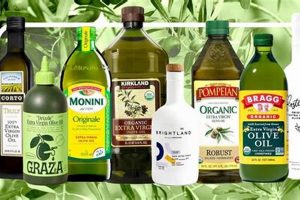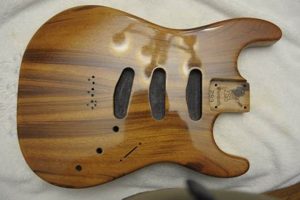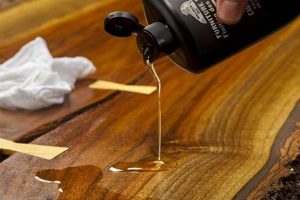This surface treatment combines the penetrating protection of oils with the lustrous sheen and water resistance of waxes. Applied to wood, it creates a durable, aesthetically pleasing surface. A common example is a mixture of linseed oil and beeswax, carefully applied and buffed to a smooth finish.
The appeal of this treatment lies in its ability to enhance the natural beauty of wood while offering a degree of protection against everyday wear and tear. It provides a warm, tactile surface, showcasing the grain and character of the wood. Historically, it has been favored for its ease of application and repair, and its ability to create a low-sheen, natural look.
The following sections will detail the application process, explore various types of oils and waxes suitable for this treatment, and discuss maintenance techniques for ensuring a long-lasting and beautiful result.
Application Guidance
Proper application is critical to achieving the desired results and ensuring the longevity of the treatment. The following tips provide guidance for a successful application process.
Tip 1: Surface Preparation: Ensure the wood surface is clean, dry, and free of any existing finishes. Sanding with progressively finer grits is essential for achieving a smooth and even absorption of the treatment.
Tip 2: Application Technique: Apply thin, even coats. Over-application leads to a sticky, uneven finish. Use a lint-free cloth or brush to work the mixture into the grain.
Tip 3: Drying Time: Allow adequate drying time between coats. The drying time will vary depending on the specific oil and wax composition, ambient temperature, and humidity. Refer to the manufacturer’s guidelines.
Tip 4: Buffing: Buffing is crucial for achieving a smooth, lustrous surface. Use a clean, soft cloth or a buffing pad after each coat has dried. This removes excess residue and enhances the shine.
Tip 5: Temperature Considerations: Apply in a well-ventilated area with moderate temperature. Extreme temperatures or humidity can affect the drying and curing process.
Tip 6: Testing First: Before applying to the entire project, test the mixture on a small, inconspicuous area to ensure the desired color and finish are achieved.
Adhering to these application guidelines maximizes the protective and aesthetic qualities of the treatment, leading to a durable and visually appealing result.
The subsequent sections will delve into maintenance procedures, addressing how to preserve the integrity and appearance of the treated surface over time.
1. Penetration Depth
Penetration depth is a primary determinant of the protective qualities of a wood treatment. This treatment, relies on the oil component to penetrate the wood fibers, carrying dissolved waxes deeper into the substrate. A greater penetration depth results in improved resistance to moisture absorption, dimensional changes due to humidity fluctuations, and surface abrasion. The depth of penetration directly influences the longevity and resilience of the treated wood.
The specific type of oil used significantly impacts penetration. Oils with lower viscosity and smaller molecular structures, such as linseed oil or tung oil, typically exhibit superior penetration compared to heavier oils. For instance, applying a blend with a higher proportion of linseed oil will generally result in deeper saturation of the wood. However, excessive penetration without proper curing can lead to a soft, uncured layer beneath the surface, highlighting the need for a balance in the formula and application process. In the restoration of antique furniture, understanding the original penetration depth of the finish is crucial for selecting compatible restoration products and techniques. In cases where the wood is extremely dense, such as ebony or some tropical hardwoods, achieving sufficient penetration may require multiple applications and extended drying times.
Ultimately, understanding the relationship between oil properties, penetration depth, and the desired performance characteristics of the treatment is paramount. While deeper penetration generally enhances protection, careful consideration must be given to the wood species, oil type, and application method to ensure optimal results. Neglecting these factors can lead to either insufficient protection or undesirable surface characteristics, underscoring the need for informed decision-making in the selection and application of this treatment.
2. Durability Level
The durability achieved through an oil and wax finish is a critical performance characteristic that dictates its suitability for various applications. It’s a composite property influenced by multiple factors intrinsic to both the materials used and the application technique. Unlike film-forming finishes, this treatment relies on penetration and surface saturation, offering a different mode of protection against wear.
- Oil Composition and Curing
The type of oil employed significantly impacts durability. Oils that polymerize and cure effectively, such as tung oil or polymerized linseed oil, contribute to a harder, more resilient surface. Insufficient curing due to improper oil selection or application can result in a soft, easily damaged finish. For example, furniture in high-traffic areas requires oils with robust curing properties to withstand repeated abrasion.
- Wax Type and Hardness
The wax component provides a degree of surface protection and enhances water resistance. Harder waxes, such as carnauba wax, offer greater scratch resistance than softer waxes like beeswax. The ratio of wax to oil is also crucial; an excess of wax can lead to a brittle finish, while insufficient wax reduces water repellency. Consider the difference between a table used for dining, requiring greater water resistance, and a decorative item where aesthetics are prioritized over heavy use.
- Application Technique and Layering
Proper application technique plays a pivotal role in achieving optimal durability. Thin, even coats, allowed to fully cure between applications, build a more resilient and protective layer than a single, thick coat. Insufficient surface preparation, such as inadequate sanding, can compromise adhesion and reduce the overall durability of the finish. For instance, applying the finish to a wood floor requires meticulous sanding and multiple coats to withstand foot traffic.
- Maintenance and Replenishment
Regular maintenance, including cleaning and periodic reapplication of a maintenance wax or oil, is essential for preserving the durability of the finish. Neglecting maintenance allows the protective layer to degrade, exposing the wood to damage. A well-maintained surface can significantly extend the lifespan and aesthetic appeal of the treated object. Consider how regular waxing of a wooden countertop can prevent staining and water damage.
In summary, the durability of an oil and wax finish is not a fixed property but rather a dynamic attribute shaped by the interplay of material selection, application technique, and ongoing maintenance. Selecting the appropriate oil and wax combination, applying it correctly, and implementing a routine maintenance schedule are all essential for maximizing the protective benefits and ensuring the longevity of the treated surface. The longevity hinges upon an informed and diligent approach.
3. Aesthetic Appeal
The aesthetic appeal derived from an oil and wax treatment stems from its capacity to enhance the wood’s inherent characteristics rather than obscuring them. The treatment penetrates the wood fibers, accentuating the grain pattern and natural color. The resulting finish exhibits a low-sheen luster, creating a tactile surface that invites interaction. This understated elegance distinguishes it from high-gloss, film-forming finishes. The application allows the wood’s intrinsic beauty to remain visible, providing a warmer, more natural aesthetic than many synthetic alternatives.
Different wood species react uniquely to this treatment, resulting in a spectrum of aesthetic outcomes. For example, walnut wood, when treated, often displays a richer, deeper tone, emphasizing its dark, swirling grain. Conversely, maple wood exhibits a subtle warmth and clarity, preserving its light, clean appearance. This versatility allows for customization, enabling the achievement of specific aesthetic goals based on the wood species and the desired visual effect. Consider its application on handcrafted furniture where the wood grain is a key design element. The treatment enhances these visual elements without adding a thick, artificial layer. A carefully chosen oil and wax combination highlights the nuances of the wood, resulting in a piece with visual depth and character.
The enduring popularity stems from its ability to provide a visually pleasing and tactile surface. The treatment offers a balance between aesthetic enhancement and preservation of the wood’s natural qualities. While challenges exist in achieving a uniform finish on certain wood types or in high-wear environments, the resulting aesthetic often outweighs these considerations. The practical significance lies in the ability to create surfaces that are both visually appealing and retain a connection to the natural material, a quality highly valued in contemporary design and craftsmanship.
4. Application Ease
Application ease represents a significant advantage of oil and wax treatments, influencing their adoption across various woodworking projects. The relative simplicity of the application process, compared to more complex finishing systems, contributes to its appeal. The following facets delineate specific aspects that define the application’s user-friendliness.
- Minimal Equipment Requirements
The application typically requires minimal specialized equipment. Applicators can often use readily available items such as lint-free cloths, brushes, or pads. This contrasts with spray finishes that necessitate spray guns and ventilation systems. The low barrier to entry in terms of equipment contributes to its accessibility for both novice and experienced woodworkers. For instance, a small furniture refinishing project can be undertaken with basic tools.
- Simplified Surface Preparation
While surface preparation remains critical for any finish, the requirements are often less stringent compared to film-forming finishes. The treatment’s ability to penetrate the wood mitigates minor imperfections. Although sanding is still necessary to achieve a smooth surface, the level of precision required is typically less demanding. This advantage is particularly relevant in situations where intricate detailing or irregular surfaces make meticulous sanding challenging.
- Forgiving Application Process
The application process is generally more forgiving than that of many alternative finishes. Overlapping strokes or minor inconsistencies in application are often less noticeable. The ability of the treatment to blend and even out during the curing process reduces the risk of visible application flaws. This characteristic makes it a suitable choice for individuals with limited experience in woodworking or finishing. Consider the relative ease of spot repairs compared to the extensive sanding and refinishing required for damaged lacquer finishes.
- Easy Repair and Maintenance
The ease of repair and maintenance further enhances the practicality. Scratches and minor damage can often be addressed with a simple reapplication of the mixture to the affected area. This localized repair process contrasts with the complete refinishing often required for damaged film finishes. Regular maintenance typically involves periodic reapplication to replenish the protective layer. This simplified maintenance routine contributes to the long-term appeal.
The collective benefits of minimal equipment, simplified surface preparation, a forgiving application process, and easy repair and maintenance underscore the practical significance of application ease. These factors contribute to its widespread use and make it a compelling choice for a range of woodworking applications. The simplified nature of the treatment makes it accessible to beginners, while its aesthetic qualities and ease of maintenance appeal to experienced craftsmen.
5. Maintainability
Maintainability is an essential characteristic of an oil and wax finish, directly impacting its long-term aesthetic and protective qualities. The relative ease with which this type of finish can be cleaned, repaired, and replenished is a significant advantage. Infrequent or improper maintenance leads to gradual degradation, resulting in dullness, increased susceptibility to staining, and eventual loss of protection. This, in turn, necessitates more extensive and costly restoration efforts. For instance, a neglected wooden countertop treated with this finish will exhibit water stains and surface scratches far sooner than one that is regularly maintained.
The maintenance process typically involves gentle cleaning with mild soap and water, followed by periodic reapplication of a maintenance oil or wax. The frequency of reapplication depends on usage and environmental conditions. Surfaces subjected to heavy use, such as tabletops or flooring, require more frequent maintenance than surfaces that experience minimal wear. A key factor is the ability to spot-repair minor damages, such as scratches or watermarks, by lightly sanding the affected area and reapplying the finish. This localized approach avoids the need for complete refinishing, saving time and resources. Consider the difference between this approach and the complex refinishing process required for damaged polyurethane finishes, which often involves stripping the entire surface.
In conclusion, the maintainability of an oil and wax finish is a crucial determinant of its long-term value. Regular cleaning, periodic reapplication, and timely spot repairs preserve the surface’s aesthetic appeal and protective qualities. Neglecting maintenance leads to accelerated degradation and more extensive restoration needs. Understanding the relationship between maintenance and the longevity of the finish is essential for maximizing its benefits and ensuring a lasting, visually appealing result. The commitment to a consistent maintenance schedule ultimately dictates the success and value derived from this type of wood treatment.
Frequently Asked Questions
The following questions address common inquiries and misconceptions surrounding the application, properties, and maintenance of this treatment.
Question 1: Is oil and wax finish suitable for high-moisture environments, such as bathrooms?
While this finish provides a degree of water resistance, it is not inherently waterproof. In high-moisture environments, regular maintenance and application of a wax with strong water-repellent properties are crucial to prevent water damage. Consider alternative finishes for areas with constant exposure to water.
Question 2: How does oil and wax finish compare to polyurethane in terms of durability?
Polyurethane generally offers superior durability and resistance to scratches, chemicals, and water damage compared to this treatment. However, polyurethane creates a film on the surface, while this treatment penetrates the wood, preserving its natural texture. The choice depends on the desired aesthetic and performance characteristics.
Question 3: Can oil and wax finish be applied over existing finishes?
This treatment is typically best applied to bare wood. Existing finishes must be completely removed through sanding or stripping to ensure proper penetration and adhesion. Applying it over existing finishes will likely result in poor adhesion and an uneven appearance.
Question 4: What is the expected drying time for each coat of oil and wax finish?
Drying time varies depending on the specific oil and wax composition, ambient temperature, and humidity. Generally, allow 24-48 hours between coats. Ensure the finish is dry to the touch before applying subsequent coats. Refer to the manufacturer’s guidelines for specific drying time recommendations.
Question 5: How often should oil and wax finish be reapplied?
Reapplication frequency depends on usage and environmental conditions. High-traffic surfaces require more frequent reapplication than surfaces with minimal wear. Visually inspect the finish for signs of dryness or wear, such as dullness or water spots. A general guideline is to reapply every 6-12 months, or as needed.
Question 6: What type of maintenance is required to keep an oil and wax finish looking its best?
Regular maintenance involves gentle cleaning with a mild soap and water solution, followed by periodic reapplication of a maintenance wax or oil. Avoid harsh chemicals or abrasive cleaners, as these can damage the finish. Address scratches or watermarks promptly with spot repairs.
The proper application, maintenance and understanding of the application makes this a reliable way to protect and create a beautiful finish.
The following section explores practical application tips to ensure a successful outcome.
Conclusion
This exploration has detailed various aspects of the oil and wax finish, emphasizing its properties, application techniques, and maintenance requirements. Understanding the nuances of material selection, surface preparation, and consistent upkeep are crucial for realizing the full potential of this treatment. Its suitability for a project depends heavily on striking a balance between aesthetic desires and functional needs.
The successful utilization of the oil and wax finish demands informed decision-making and diligent practice. Further investigation and careful application will determine the longevity and beauty of the treated surface. Prudent implementation is essential to the realization of its benefits.







